Lakeland Terrier is one of those working terrier breeds, developed specifically by the natives of an England district; Lake. Native England wanted to develop a special small farm dog that could protect their cattle from badgers and sheep-stealing foxes.
Considering this job, the dog should have unmatchable energy, zesty, and furious temperament with which they could chase and hunt foxes.
Thus, after countless efforts and multiple trials, the farmers over there finally were able to produce this Lakeland Terrier that fabulously proved its strengths and capabilities as a farm dog, over time.
However, Lakeland Terrier dogs are also excellent candidates for the perfect family pets – especially for confident pet parents, who know how to cater to their pooch’s insane exercise needs.
Lakeland Terriers are loving and fun to be around, most of the time, but their super curious and mischievous nature doesn’t let them sit peacefully for long. To vent their massive energies out, Lakeland Terriers love joining their owners in all sorts of activities and dog sports.
And since it possesses independent nature, it might make it difficult for you to put a pause on this terrier’s never-ending drama – especially when they are up to chasing small animals in your backyard.
No doubt, the charm, and traits of this small dog are enough to persuade any dog lover out there, still, here are some things you need to know about the Lakeland Terrier breed, such as its history, personality, health, care, and training needs.
With this information, you can decide better whether this dog should be a part of your family or not.
So without further ado, let’s begin!
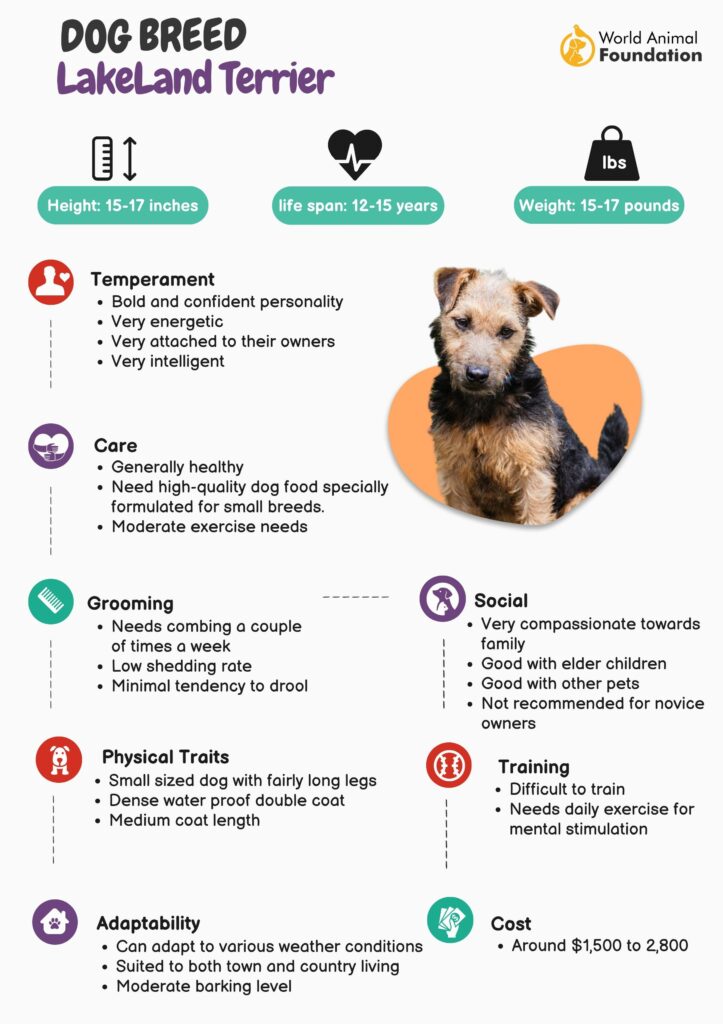
About the Breed
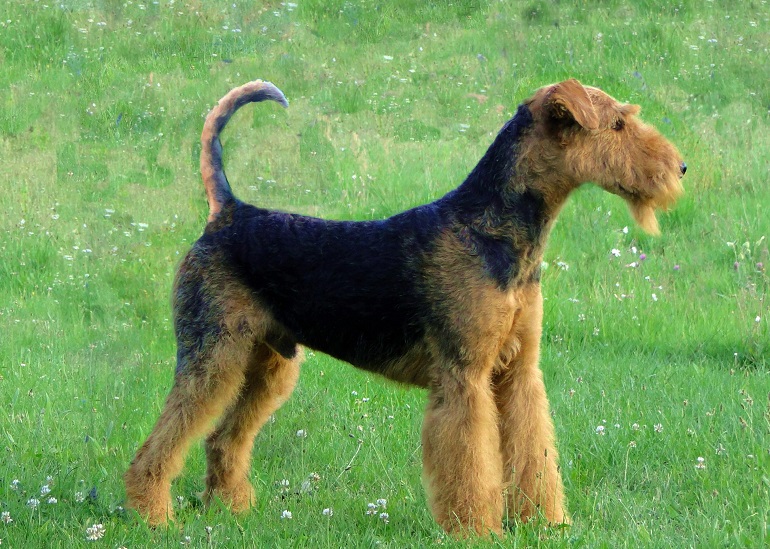
A Lakeland Terrier is a small dog with a big personality that can work like a man when it comes to hunting and chasing predators – or invaders. Since this farmer’s dog was bred to cater to the security needs of Lake’s farmers, this dog has a compact yet sturdy body.
The Lake District is full of ragged mountains and rocky dens so the small size of this dog also allows him to squeeze through those narrow spaces, with the least hassle. That’s also the biggest reason why the farmers over there prefer this small terrier over other dogs.
These terriers grow highly attached and protective of their toys and family, which makes them good protection dogs. Due to their high prey drive, they suit better to houses with no close neighbors. Otherwise, you might have to feel embarrassed in front of your neighbors, for your dog’s excessive barking.
Like other small dogs, this one is also super energetic but still, it can adapt comfortably to apartment living, as long as you are providing it enough exercise and mental stimulation – and of course, a play area to roam and play around freely.
One thing which you should keep in mind is that the Lakeland terrier is not a good option as the first dog, for first-time dog owners. Remember that, unlike other terrier breeds, this one is super difficult to housetrain.
Even though they are intelligent, they prefer to use their own brains and figure out their definition of correct behavior themselves. If you are not experienced enough, this terrier will make you pull your hair, with his unstoppable digging, barking, and growling.
On the other hand, if you’re good at training dogs or can afford to hire a skilled dog trainer, you won’t find any better four-legged friend than this small terrier. Due to so many amazing qualities, this Lakeland terrier is quite rare and you might have to wait in a long queue to finally get your name up for owning it.
History of the Lakeland Terrier
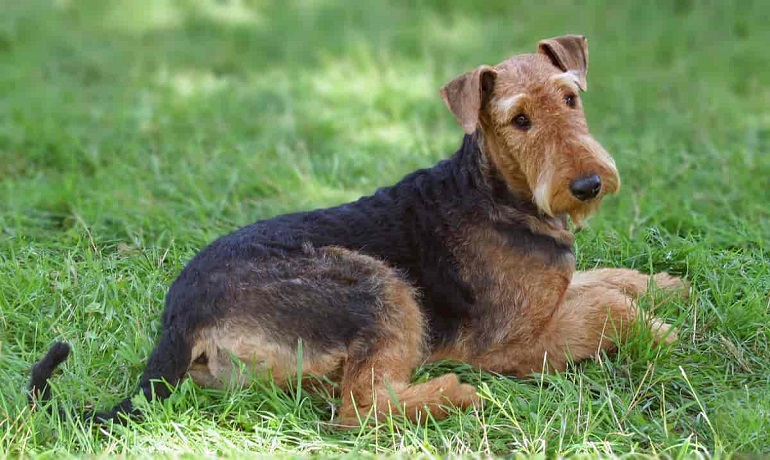
Lakeland terrier is named for the lake district; its birthplace which is located in northern England, close to the Scottish border. The entire region is full of mesmerizing hills and mountains and this breed was developed by a local breeder, Beatrix Potter; a lady who owns a huge sheep farm there.
Potter landed into huge trouble when a pack of aggressive foxes entered the region, and start preying on her cattle. This preying picked up pace during the lambing season since during the same season, foxes used to give birth to cubs.
Thus, to put a stop to this sheep stealing, Lakeland terriers were used for the very first time. As a fox terrier, this dog went to the main grounds, chased foxes and their cubs to their burrows, and killed them. Due to this very reason, this small terrier is also called the Westmoreland terrier.
In addition to fox hunting, Lakeland terriers were also used to catch rats, rabbits, maggots, and other burrowing animals. Considering their efficiencies as hunting dogs, soon they were used for other works like miners and metallurgists for ratting, rabbiting, and digging.
This terrier breed has its roots going back to about 1700, and that’s why, it possesses a close resemblance to various rare terriers too, including Tan terriers, old English terriers, Welsh terrier, Bedlington terriers, border terrier, wire fox terrier, and Dandie dinmont. Some people also believe that this dog is the first workingman’s terrier.
It was not until 1928 that the Lakie was officially recognized by the kennel club. However, the American kennel club recognized and registered Lakeland terriers as purebred dogs in 1934. After this, they won many prizes and titles in multiple show ring competitions.
For example, in 1963, a Lakeland terrier named Rogerholm recruited won the best-in-show title. He was the first Lakie to win this title. However, in 1967 & 1968, another Lakie, champion stingray won two best-in-show titles – one at the Westminster kennel club dog show and the second at the Crufts show.
Even though this breed used to be the brightest star of its time, it’s extremely rare to be found. According to some resources, only 40-80 pups of Lakeland terriers are born each year, in Germany. To prevent this ancient terrier breed from extinction, a special Lakeland terrier club is up to looking after lakies.
Lakeland Terrier Facts
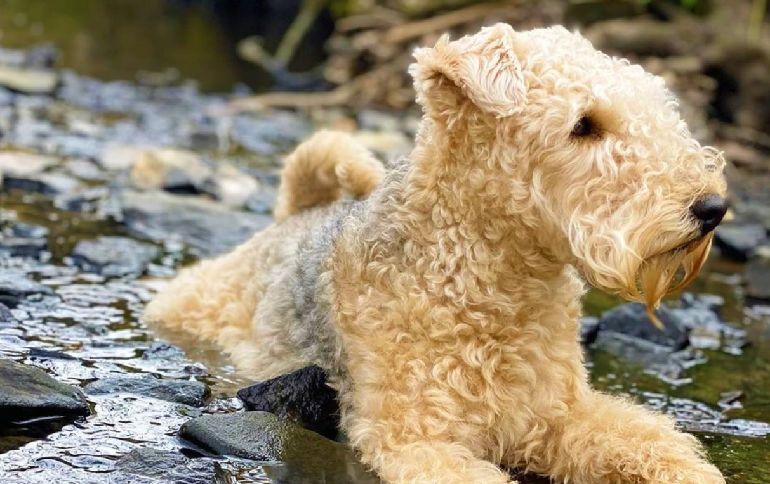
- The average life span of a Lakeland terrier dog is 12-15 years. However, if a dog, somehow, manages to live up to 16 years, he is called the Matusalem dog. Such a dog is considered to be as old as an 83-year-old human.
- In one litter, about two to three puppies are born, if bred naturally, without the influence of any other external element.
- Lakeland terriers are one of the most hypoallergenic dogs since it’s a low-shedding breed and comes with minimal tendencies to drool.
- These small animals tend to wander off easily while chasing pests or scents. Therefore, it’s important to fence your property appropriately to prevent it from escaping.
- Lakeland terriers make the perfect pet choice for dedicated owners since these dogs are more prone to develop separation anxiety than other terriers. Even if you can’t stay around your dog 24/7, consider buying some fun toys so he won’t get bored.
- In addition to having impeccable hunting skills, Lakeland terriers are also great at burrowing. One time, a dog owned by the president of the Lakeland terrier association dug a 23ft deep burrow while chasing an otter.
- Both male and female Lakeland terriers possess the same temperament. The only difference they have is their size.
Lakeland Terrier Appearance
This small terrier has a coherent body with fairly long legs, which makes them look more athletic. Due to the very same reason, this breed is also called a long-legged terrier. Other distinctive features of this dog are its rectangular head, small eyes, v-shaped ears, and long, upright tail.
Also, there’s a long beard on their muzzle, which distinguishes Lakeland terriers from their other cousins.
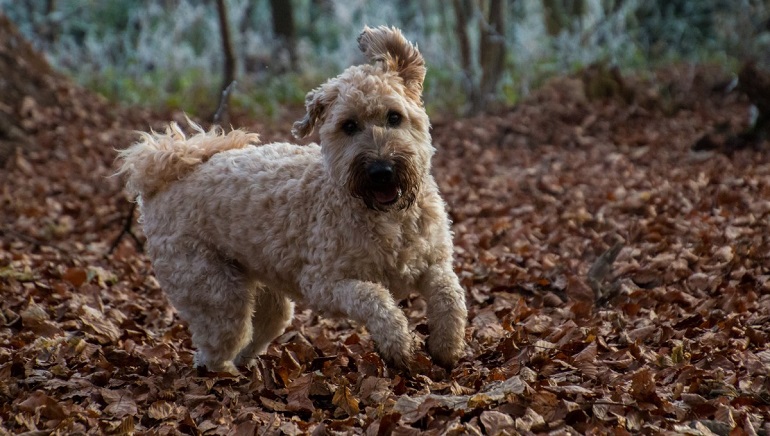
Size
Like many other terrier breeds, the females of Lakeland terriers are also shorter than males. They tend to grow about 15-17 inches tall from the shoulder.
Weight
The weight of Lakeland terriers may vary based on their heights. Generally, the healthy weight range of a lakie is 15-17 pounds. Likewise, males are heavier than females.
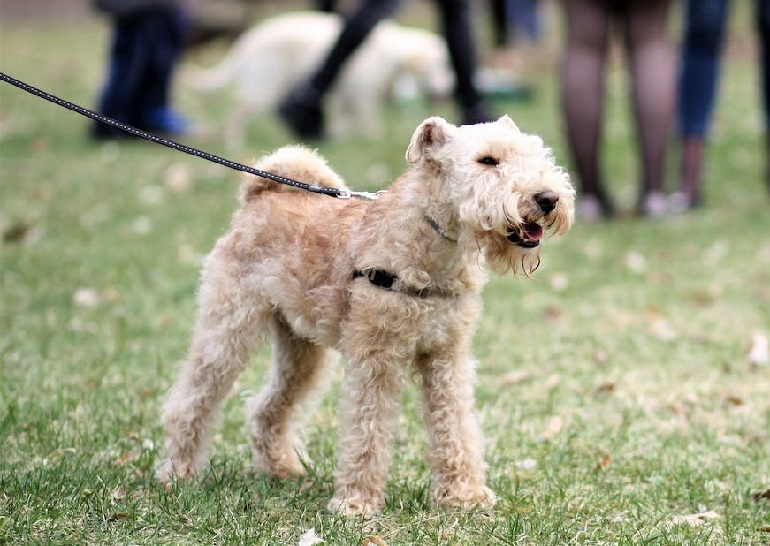
Coat
Lakeland terriers tend to have special, dense, and waterproof double coats. It comprises a thick & soft undercoat and a rough and wiry outer coat. The double coat protects the dog from weather extremes since it acts as insulation against temperature fluctuations. The coat could either be wavy or straight.
Color
Speaking of coat color, you’d get to see a wide variety, including blue, beige, brown, red grizzle, liver, wheaten, black, and tan. Some Lakie’s coat also features special marking around the torso and paws, however, reputable breeders don’t like these markings much.
Lakeland Terrier Temperament and Personality
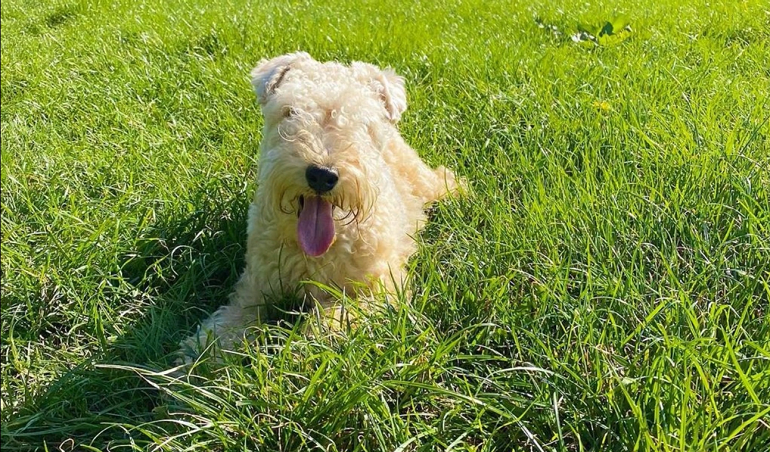
Lakeland Terriers are friendly, affectionate, and playful most of the time and can never resist interaction with a human. Since it’s always on his toe, in a ready-to-go posture, one may think that the Lakeland Terrier is not a dog to cuddle, but that’s not the case.
If you take them for daily strolls of at least one hour, they won’t mind giving you some good cuddles – just make sure there’s no distraction in the room otherwise they’ll leap onto it.
As much as it’s loving and compassionate towards its family, it might be super reserved to the guests and strangers. The same goes for the newer pets. Generally, Lakeland Terrier doesn’t mind sharing their living space with other dogs, they can be repulsive, and sometimes aggressive, towards other animals like mice, rabbits, and cats.
Even with dogs, they’ll always be on the brisk of breaking out and would never back out of a fight. To minimize the Lakeland Terrier aggressiveness, it’s better to socialize them at a young age. This early socialization will make your lakie well-mannered around strangers and when outside.
Some breeders have confirmed that the temperament of a Lakeland Terrier depends highly on its parent’s temperament. If his mother or father is aggressive, no amount of training will be enough to correct his behavior.
Therefore, it’s advised to purchase your lakie puppy from a reputable breeder. Lastly, since the Lakeland Terrier is mostly good and gentle towards kids, it makes a good choice for a family pet. However, you’d need to teach your kid how to be gentle on Lakie’s small size and fragile body.
Lakeland Terrier Health and Care
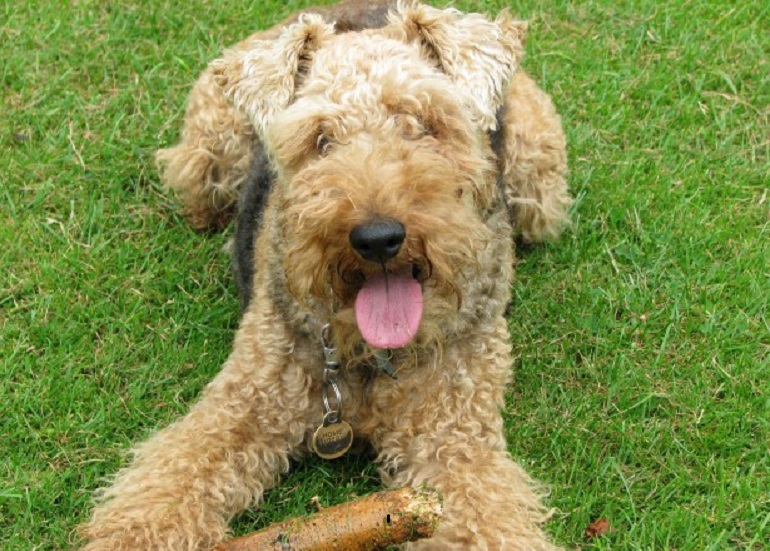
Being a hardy, purebred dog breed, the Lakeland Terrier is not prone to catching hereditary disorders. Still, like other breeds, this one comes with a high risk of developing patellar luxation – displacement of the kneecap. Besides, some dogs might develop severe heart and eye problems, after not receiving proper care.
The official US Lakeland Terrier Club has confirmed that only 1% of lakies tend to develop health defects, making it one of the healthiest dog breeds out there. Experts say that if your Lakeland terrier is getting a proper diet, enough physical and mental stimulation, and attention, he will stay in his fittest form throughout his life.
When it comes to the care of a Lakeland terrier, the most important factor you should pay attention to is food consumption. Even though they can eat almost all types of simple food happily, not having any food intolerance, you better go with the high-quality dog food specially formulated for small breeds.
You can find the serving recommendation on the food can for dogs of every size; pup and adult dog. However, it would be better if you consult a vet so he could brief you about the most appropriate serving size, based on your dog’s size, metabolism, weight, energy level, etc.
Remember that Lakeland terriers possess a huge risk of getting overweight so you better keep a check on their daily calorie intake and limit treats to a certain number.
On the other hand, when it comes to grooming, the Lakeland terrier is considered the lowest-maintenance terrier out there. You don’t need to worry about infections or skin problems. The only thing you need to do in terms of grooming is to remove the dead hair.
Yes, Lakie’s coat doesn’t shed too much, the dead hair needs to be removed so it won’t get tangled. Don’t expect it to fall out automatically since the hair is too short.
Another technique that is used to take care of your dog’s wiry coat is hand stripping in which you pick the old, loose hair by hand to encourage new growth. You can either do this hand stripping yourself or hire a professional groomer for the job.
Besides, regular clipping and trimming of the coat are also mandatory. However, you don’t need to get a salon appointment to get your dog properly groomed. With the right tools and a little practice, you can do the job at home.
Speaking of your dog’s hygiene, it shows lower tendencies to drool, the Lakeland terrier doesn’t smell filthy. But still, you better arrange a bath for him every 4-6 weeks. To maintain oral hygiene, brush your canine’s teeth daily. Also, clean the ears regularly to prevent infections.
Most importantly, give your Lakeland terrier as much attention as possible. Take this lively terrier along with you on camping, bike rides, and extensive walks.
But don’t forget, they can wander off easily while getting distracted by the scents of other animals. Therefore, never let them roam around the camping sight off-leash, and keep an eye on them.
Even when your lakie is playing in the backyard, keep him on the leash to prevent him from chasing the neighboring pet or stray animals. However, if you are an introvert, you can keep this terrier busy with other indoor challenges like puzzle, mind games, or interactive toys.
Lakeland Terrier Training
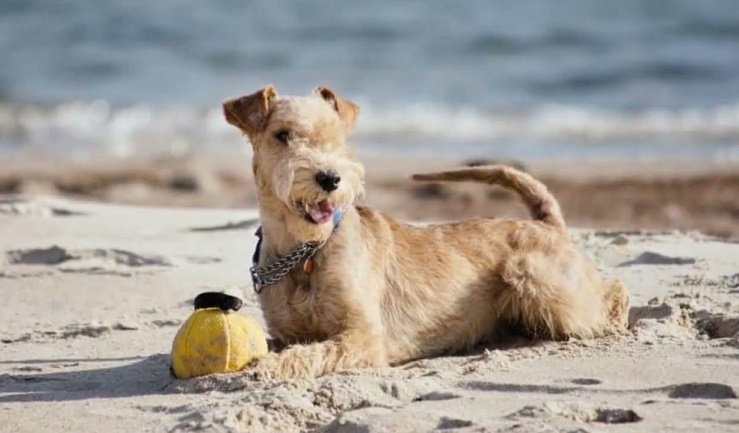
No doubt that Lakeland terriers are incredibly intelligent but you need to remember that they work as per their own will. If a lakie is not in the mood to learn something, he won’t – regardless of how hard or for how long you try.
Never think about using negative reinforcement techniques to train pups and adults because doing so may cause aggression and depression in your pet. The best way to train a Lakeland terrier is by using positive reinforcement tactics like play, praise, patting, toys, and food-based reward.
Also, you need to make sure that your training sessions are not too long otherwise your pup might get bored of them. Even if the training lesson is small, keep it fun and cheerful since this way, your dog will learn newer things more quickly and efficiently.
Most importantly, indulge him in social activities from an early age since adult lakies are hard to teach. Make sure you are training your canine in a securely fenced area otherwise he would pay more attention to the dog next door than the lesson.
Besides training them for obedience, agility, and mannerism, you should also train them to sleep at a certain place in the house. Otherwise, every corner of your home will automatically turn into his play area.
However, before sleep training, think about the sleeping space of your dog thoroughly. Remember that this terrier is going to copy everything you do in your day-to-day life. So, specify a corner where you and other members of your family behave well.
In addition to this, potty training and crate training is also important to keep things easier down the road. For potty training, take your dog to the potty after every meal, after every playtime, and after every nap. When he starts to go to that certain spot on his own, reward him with his favorite treat.
Similarly, crate training will help teach your dog how to respect boundaries. Lock him inside the crate for a few minutes every day otherwise, he might develop anxiety.
Conclusion
Even though the Lakeland terrier is one of the rarest dog breeds, chances are high that you might find it in rescue groups and shelter homes.
We always recommend preferring adopting adult dogs over buying pups since adult canines are easy to deal with.
Also, by doing so, you can contribute, in the best way possible, to make this planet more livable.












